Uncategorized
You see an ugly ottoman or a faded armchair; she sees a lost history waiting to be revived
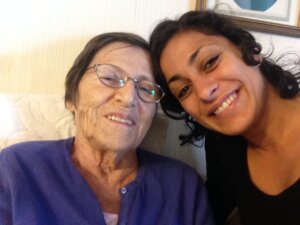
Even when she was a little kid, Ruti Wajnberg knew her grandma’s brown ottoman was ugly. She loved it anyway. Whenever she and her sisters would make the trek from New Jersey to visit their grandmother in Brighton Beach, they would roll around on the mushroom-shaped seat.
“It’s in all my memories of her apartment,” Wajnberg told me at her upholstery studio in Brooklyn. “It was my grandma’s, it’s tied up with my memories of her, and I wish I had it.”
To be clear, the brown would have to go. “I would have ripped that fabric off that stool so fast,” said Wajnberg, 41, a former product manager and software developer who started her reupholstery business Find the Thread two years ago to give new life to old furniture. “It would be so meaningful to me to have it, to watch my kids roll on it; that would bring me to tears.”
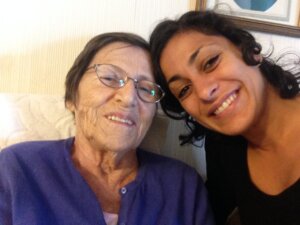
As the granddaughter of Holocaust survivors and the daughter of Jews who were expelled from Communist Poland in 1968, Wajnberg doesn’t have many heirlooms. More than once, her family has been forced to leave everything behind — including, in her grandparents’ cases, the loved ones who perished at the hands of the Nazis.
When Wajnberg’s parents fled Poland as teenagers — her mother’s family to Israel and her father’s to New York via Italy — they could take very little with them. Her mother told her she’d tucked a portrait a friend had painted of her in her suitcase. It was confiscated.
“That always struck me as so sad, that experience of just arriving completely empty-handed,” said Wajnberg, who wrote her undergrad thesis at NYU about her family history. This sense of loss is part of what drew her to saving and reviving furniture imbued with personal meaning.
“I don’t have that line of connection to anything in the past. I don’t have photographs of my great grandparents, anything that belonged to them,” she said. “Possessions carry a lot of stories. They’re a reason to talk about the person and remember them.”
As ugly as the brown ottoman may have been, she wishes she’d had the foresight to ask for it when her grandmother — who was her “bestie” when she was young — died in 2016. “When we go to Brighton Beach, I talk about my grandparents, because I’m in their space,” she said. “But I’m never in their space in my space.”
These days, people come to her with all kinds of projects: thrift finds that need zhuzhing, built-in window seats that require oddly shaped cushions, salvaged church pews that could use dressing up, fabric purchased on vacation that they want to put to use, faded furniture they don’t want to part with, and pieces they inherited.
“Most often I get, ‘This was my grandma’s,’” she said. “That’s my favorite. If it was your grandma’s, I’m in.”
Finding the thread
The first thing Wajnberg ever upholstered, coincidentally, was an ottoman. “I found an upholstery class in the East Village that sadly doesn’t exist anymore, and I signed up for it, having no idea that I would like it. I just wanted a creative outlet,” said Wajnberg, who was working as a product manager at the time. She still has the ottoman she made from scratch. Looking back with a more expert eye, she said, “it’s not very well-made.” But she loved the process. The tactile, physical experience reminded her of the time she spent working in the garden on a kibbutz in Israel, and she craved more of it.
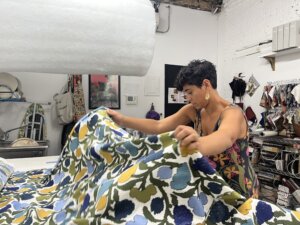
Like many first-generation Americans growing up with immigrant parents, Wajnberg didn’t always imagine this path. “The idea of an artistic life or career was not really presented as an option,” said Wajnberg, the third of four girls. Music was a huge part of her childhood in New Jersey — all the kids played piano and another instrument and sang in choirs — and she always loved making things. But the arts felt more like “a hobby option.”
“My parents understandably had this feeling that nothing that you have is yours, except for your education,” she said. “People can take your stuff and people can take your passport, and the only thing you really have is your brain.”
Wajnberg started college at NYU thinking she’d study journalism, but quickly switched to history, and interned at the Museum of Jewish Heritage. After graduation, she moved to Israel to work on a kibbutz for six months and spend time with her other grandparents in Tel Aviv. She ended up staying for three years, earning an MBA from Reichman University and taking on her first jobs in tech.
When she returned to the States, Wajnberg worked as a product manager and later pivoted to become a software developer. All the while, she kept up her upholstery hobby. After her first son was born, she remembered, she’d often put him to sleep, then head down to the unfinished basement of their building, “and just rip things up and put them back together.” She was taking online courses, watching YouTube videos, and traveling occasionally for courses wherever she could find them.
“I just knew I loved it. But I also liked my job,” she said. “I fantasized about being an upholsterer and I would meet women my age-ish who had their own shop, and it just felt so unattainably cool to me and not really a practical option,” she said. “I really had to work to shed the practicality of what I thought I needed to be doing.”
Then the pandemic hit. Wajnberg had just had her second son and when she returned from leave in the midst of lockdown, she realized she didn’t like working remotely, without the human interactions that were her favorite part of the job. She went down to four days a week so she could work Fridays at the Brooklyn upholstery studio Stitchroom.
“After a couple of weeks, I was just like, ‘This is all I can think about. This is all I want to do,’” she said. She parlayed it into a full-time job as the shop’s head of production. Three years in, she felt ready to open up a shop of her own.
‘Making things’
Wajnberg’s studio is nestled on the third floor of a building with office lofts and artist spaces across from the Brooklyn Navy Yard. A window in the back corner spills natural light onto a small desk and three sewing machines. Up front there’s a large worktable and a couple projects in progress pushed against the sides of the space. On the day I visited, there was a Victorian sofa half-dressed in yellow, green and blue flowers, and a chair waiting to be adorned in gold chenille.
Her apron, hanging by the door, is covered in leaves and flowers, a cheerful mess of reds, yellows, oranges, pinks, and greens. “I, you may have noticed, am a floral gal,” she said.
“They make me smile. They make me happy. They make me feel lighter,” she added. “I just want to be drenched in flowers while I upholster things in flowers.”
The jubilant fabrics and the warmth of Wajnberg’s personality belie what has been, in some ways, a difficult first chapter. “I’ve really only had this business in times of great pain,” Wajnberg said. She started Find the Thread in September 2023, just weeks before the Hamas attacks on Oct. 7. “I have a lot of people there,” she explained, people she loves and worries about in Israel, including all of her family on her mother’s side and friends she made while living there. “It’s painful, regardless of what your political beliefs are.”
“Like many people who come from a lineage of trauma, I have a very busy, anxious mind,” Wajnberg said. “And I really feel centered and calmer when I’m working with my hands.” To offer others the same kind of outlet — and an introduction to upholstery — she’s been giving monthly classes in her studio, teaching participants to make throw pillows or reupholster one of their own dining room chairs.
“People are really craving tactile accomplishment,” she said. At the end of each workshop, when everyone pauses and looks at what they’ve created, “there’s this real sense of pride in the room. Like, ‘I made this, I just made this thing with my hands,’” she said. “It feels so good.”
Reviving and renewing
There’s an armchair that’s been sitting in Linda Ellman’s living room in Brooklyn for decades. It was there when her two daughters were growing up, and it’s there now when her four grandchildren come over after school — the perfect cozy spot to cuddle up and read together. It always conjured up memories of a similar chair that Ellman used to sit in to read with one of her parents or her grandma when she was a kid.
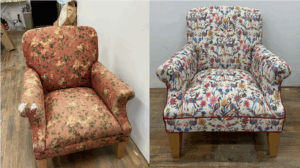
“One of the important things we do with children is we hold them close, we read things to them that help them think about themselves and the world,” Ellman, a retired teacher, told me over the phone. “I’m continuing the tradition. I lived near both my grandparents and they were very much in my life, and these kids are very much in my life.”
When the fabric started falling apart, Ellman considered buying a new chair. But she was attached to the chair she already had and the many years of memories it held. So she decided to reupholster it instead, and a friend referred her to Wajnberg.
After prospective clients reach out for an initial quote, the first step is fabric selection. Wajnberg works primarily with “regular people,” rather than interior designers and other industry professionals, so she often has to guide them to figure out what they want. “I think I’ve gotten really good at pulling other people’s style out of them,” she said.
At first, she’d ask people what they were looking for and bring samples to them. Until she realized most people have no idea. Now they usually come to her studio, so she can observe their reactions closely and pull from her entire library. They may think they want one thing, and ultimately fall in love with something else. Ellman, for instance, was looking for a romantic floral pattern to echo the muted red fabric she’d had, but ended up with a bright jungle print.
“You can always say no later, so this is the moment to push yourself out of your comfort zone and have fun and explore,” said Wajnberg, who sends clients swatches so they can put them in the room, mull it over, solicit opinions, “let their pet play with it and see if they can destroy it,” and “come to a leisurely decision.” And, she said, “if you get home and you want beige, you get beige.”
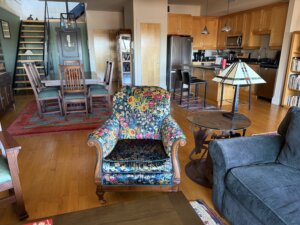
Judy Mann was looking for green. Her armchair had been fading in the sun. “It was going from this magnificent pattern to kind of grayish nothing,” she told me on Zoom. She turned to Wajnberg, her neighbor, for help. “She’s warm and charming and has a sparkle to her,” said Mann, who is the retired COO of Jewish Funders Network.
Mann’s armchair project cost around $2,300, including about $800 in labor costs. It was more than she’d intended to pay to replace or refresh her chair, mostly because of the pricey fabric. According to Wajnberg, people often underestimate the cost compared to the now-ubiquitous fast furniture. Reupholstering a simple dining chair might run $100, while a complex sofa might be $4,000 or $5,000. But Ruti “conveys confidence,” Mann said. “So if I was gonna spend this kind of money, I was quite sure it was going to be worthwhile.”
Together, Mann and Wajnberg selected an arresting pattern of colorful, overgrown flowers — “wild meadow free spirit vibes,” as Wajnberg put it on Instagram. It was a departure from the green “tribal” pattern of the original chair but still fit the color scheme. “It ended up being way better than I imagined,” Mann said.
“It’s extraordinarily beautiful, in my opinion,” she said. “I’m always shocked if someone comes in and doesn’t comment about the chair.”
For Mann, Ellman, and others who have a sentimental attachment to the furniture they bring her, Wajnberg has a surprise: She makes them a small pillow out of the original fabric. “Oftentimes it’s the fabric underneath the cushion or somewhere out of the way that reveals the true color,” she said. “I’ll try to find a piece that’s vibrant, which I think is really emotional for people, because sometimes they haven’t seen it that way in so long.”
In the two years since Wajnberg started Find the Thread, she’s reupholstered everything from a settee inherited from a late grandfather’s vintage store to the chairs at Pitt’s, a new Red Hook restaurant by Agi’s Counter chef Jeremy Salamon, to a neighbor’s grandparents’ Torah scroll.
Wajnberg can’t say for sure that this is the final stop on her winding career path, but right now, it feels right. “I feel so much more like I’m part of this humming local economy than I used to when I was making things on the internet that faraway people would use,” she said.
The post You see an ugly ottoman or a faded armchair; she sees a lost history waiting to be revived appeared first on The Forward.
Uncategorized
Israel’s Netanyahu to Discuss Second Phase of Gaza Plan with Trump Later This Month

Trucks transport tanks on the Israeli side of the border with Gaza, Israel, November 18, 2025. Photo: REUTERS/Amir Cohen
Israeli Prime Minister Benjamin Netanyahu said on Sunday that the second phase of a US plan to end the war in Gaza was close, but cautioned several key issues still needed to be resolved, including whether a multinational security force would be deployed.
Netanyahu, speaking to reporters alongside German Chancellor Friedrich Merz in Jerusalem, said that he would hold important discussions with US President Donald Trump at the end of the month on how to ensure the plan’s second phase was achieved.
The prime minister’s office in November said that Trump had invited Netanyahu to the White House “in the near future,” although a date for the visit has not yet been made public.
Netanyahu said that he would discuss with Trump how to bring an end to Hamas rule in Gaza. A ceasefire between Israel and Hamas is entering its second month, although both sides have repeatedly accused each other of violating the truce agreement.
Netanyahu said that it was important to ensure Hamas not only upholds the ceasefire but also follows through on “their commitment” to the plan to disarm and for Gaza to be demilitarized.
Israel retained control of 53 percent of Gaza under the first phase of Trump’s plan, which involved the release of hostages held by terrorists in Gaza and of Palestinians detained by Israel. The final hostage remains to be handed over are those of an Israeli police officer killed on October 7, 2023 fighting Gazan militants who had invaded Israel.
“We’ll get him out,” Netanyahu said.
Since the ceasefire started in October, the terrorist group has reestablished itself in the rest of Gaza.
GERMAN CHANCELLOR: PHASE TWO MUST COME NOW
According to the plan, Israel is to pull back further in the second phase as a transitional authority is established in Gaza and a multinational security force is deployed, Hamas is disarmed, and reconstruction begins.
A multinational coordination center has been established in Israel, but there are no deadlines in the plan and officials involved say that efforts to advance it have stalled.
“What will be the timeline? What are the forces that are coming in? Will we have international forces? If not, what are the alternatives? These are all topics that are being discussed,” Netanyahu said, describing them as central issues.
Merz said that Germany was willing to help rebuild Gaza but would wait for Netanyahu’s meeting with Trump, and for clarity on what Washington was prepared to do, before Berlin decides what it would contribute but that phase two “must come now.”
NETANYAHU: WEST BANK ANNEXATION REMAINS A SUBJECT OF DISCUSSION
Netanyahu said that he would also discuss with Trump “opportunities for peace,” an apparent reference to US efforts for Israel to establish formal ties with Arab and Muslim states.
“We believe there’s a path to advance a broader peace with the Arab states, and a path also to establish a workable peace with our Palestinian neighbors,” Netanyahu said, asserting Israel would always insist on security control of the West Bank.
Trump has said he promised Muslim leaders that Israel would not annex the West Bank, where Netanyahu’s government is backing the development of Jewish settlements.
The “question of political annexation” of the West Bank remains a subject of discussion, Netanyahu said.
Uncategorized
Frank Gehry, renowned architect who began life as Frank Goldberg, dies at 96
(JTA) — Frank Gehry, a Jewish architect who became one of the world’s most renowned innovators in his field for his contributions to modernist architecture, including the famed Guggenheim Museum in Bilbao, Spain, has died at 96.
His death following a brief respiratory illness was confirmed on Friday by the chief of staff at his firm, Meaghan Lloyd, according to the New York Times.
Gehry was born Ephraim Owen Goldberg on Feb. 28, 1929, to a Jewish family in Toronto. In 1947, Gehry moved to Los Angeles with his family and later went on to graduate from the University of Southern California’s School of Architecture in 1954.
The same year, he changed his name to Gehry at the behest of his first wife who was “worried about antisemitism and thought it sounded less Jewish.” He would later say he would not make the choice again.
Among Gehry’s most acclaimed works, which feature his signature, sculptural style, are the Bilbao Guggenheim, the Walt Disney Concert Hall in Los Angeles, the Louis Vuitton Foundation in Paris and the DZ Bank Building in Berlin.
Gehry also often returned to the motif of a fish, including two large fish sculptures in the World Trade Center in New York City and on Barcelona’s seafront. Some tied the fish motif to his recollections about his Jewish grandmother’s trips to the fishmonger to prepare for Shabbat each week.
“We’d put it in the bathtub,” Gehry said, according to the New York Times. “And I’d play with this fish for a day until she killed it and made gefilte fish.”
Gehry began to identify as an atheist shortly after his bar mitzvah. But in 2018, while he was working on ANU-Museum of the Jewish People in Tel Aviv, he told the Jewish Journal that Judaism had influenced his career nonetheless.
“There’s a curiosity built into the [Jewish] culture,” he said. “I grew up under that. My grandfather read Talmud to me. That’s one of the Jewish things I hang on to probably — that philosophy from that religion. Which is separate from God. It’s more ephemeral. I was brought up with that curiosity. I call it a healthy curiosity. Maybe it is something that the religion has produced. I don’t know. It’s certainly a positive thing.”
In 1989, Gehry won the prestigious Pritzker Prize, considered one of the top awards in the field of architecture, and in 1999 won the Gold Medal from the American Institute of Architects. In 2007, Gehry also received the Jerusalem Prize for Arts and Letters and in 2016 won the Presidential Medal of Freedom from then-president Barack Obama.
His survivors include his wife, Berta Isabel Aguilera, daughter Brina, and sons Alejandro and Samuel. Another daughter, Leslie Gehry Brenner, died of cancer in 2008.
The post Frank Gehry, renowned architect who began life as Frank Goldberg, dies at 96 appeared first on The Forward.
Uncategorized
Herzog Says Wellbeing of Israelis His Only Concern in Deal With Netanyahu’s ‘Extraordinary’ Pardon Request

Israeli President Isaac Herzog speaks during a press conference with Latvian President Edgars Rinkevics in Riga, Latvia, Aug. 5, 2025. Photo: REUTERS/Ints Kalnins
i24 News – In an interview with Politico published on Saturday, Israeli President Isaac Herzog remained tight-lipped on whether he intended to grant Prime Minister Benjamin Netanyahu’s “extraordinary” pardon request, saying that his decision will be motivated by what’s best for Israel.
“There is a process which goes through the Justice Ministry and my legal adviser and so on. This is certainly an extraordinary request and above all when dealing with it I will consider what is the best interest of the Israeli people,” Herzog said. “The well-being of the Israeli people is my first, second and third priority.”
Asked specifically about President Donald Trump’s request, Herzog said “I respect President Trump’s friendship and his opinion,” adding, “Israel, naturally, is a sovereign country.”
Herzog addressed a wide range of topics in the interview, including the US-Israel ties and the shifts in public opinion on Israel.
“One has to remember that the fountains of America, of American life, are based on biblical values, just like ours. And therefore, I believe that the underlying fountain that we all drink from is the same,” he said. “However, I am following very closely the trends that I see in the American public eye and the attitude, especially of young people, on Israel.”
“It comes from TikTok,” he said of the torrent of hostility toward Israel that has engulf swathes of U.S. opinion since the October 7 massacre and the subsequent Gaza war, “from a very shallow discourse of the current situation, pictures or viewpoints, and doesn’t judge from the big picture, which is, is Israel a strategic ally? Yes. Is Israel contributing to American national interests, security interests? Absolutely yes. Is Israel a beacon of democracy in the Middle East? Absolutely yes.”


